Game Pile: Super Solvers’ Midnight Rescue
July 2020 Wrapup!
Hey, July’s down. We’re getting this year done, day by day, people. If you’re still here with me, thank you so much for that.
This month seems to have had a theme of catching up; the writing schedule has been better, in general, with very few days where I fell behind, and there have been some articles that I wrote months ago that I threw forward into July, the ‘infinity away’ year. Also it was time to dust out and finish off some drafts I had been leaving alone for literally years.
Comically, this did mean one article came out just after a major conversation about its subject matter despite being originally written like, a year ago. Oops. That was the Cards Against Humanity article, because every year I teach students about making games, I see more variants on it, and they’re almost always weaker games because of the overwhelming presence of Cards Against Humanity. Which is a bummer!
I also finally did my set on the Fullmetal Alchemist franchise, from manga to the first anime to the second anime to the live-action movie. There’s more, of course – a few more movies and videogames, and man, there’s probably a card game or something – but I finally got my feelings out there about what is, again, probably the best series of its kind that nonetheless has some ways it’s bad.
I also finally penned that piece on Brolonialism, which has been waiting for years; I put out some thoughts about how ‘cancel culture’ isn’t really a thing, looked at tackling the Nephilim from Magic: The Gathering, which is maybe a month old at this point, and even did a writeup of my character Moonheart, from City of Heroes. Also, because I try to keep myself to one 3rd ed D&D article per month, I spent this month banging on the Spelldancer, one of the most hilariously broken loops you can have in a game that normally abhors loops.
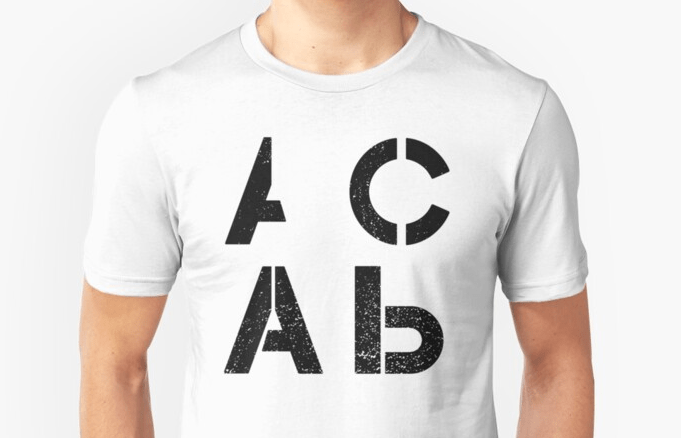
July’s shirt continues on my theme of Loss-themed shirts! There are two new additions to the Loss Collection: a lettered and numbered version of the same idea. It’s not a complicated design, but I’m very happy with being able to use the simple elegance of it, in a way that works as a design even without being able to see the Loss element to it.
Video? I did put up a small video explaining a Minecraft thingy I made, a Hopper Loader. But that’s not the ‘proper’ video for this month, no no. This month’s video is a game pile video, which you shouuuld be getting to see tomorrow. Keep your eyes peeled.
Personal life, hm, hm, hm, well this is a break month between two semesters, during which time I’ve been doing set up and consultation for my various work arrangements. I’ve felt obviously busy, and dealing with a lot of best practice stuff about health and contamination, which gets more awkward as schools open up and second waves of infections kick off. I try not to talk about the pandemic much here, but it is affecting me, and I’m trying to make sure the content I put here is an escape from gloom rather than an embrace of that feeling. You know how it goes, and I hope it’s been helpful, even as I’ve been doing my best to be honest with you about my work process.
Australian Slavery
Hey, just before we dive into a month with a theme, let’s clear the decks with this one. Content warning: Slavery!
July Shirt: Absolute Cdestiny ApocalyBse!
Sooo, hey.
Police eh.
They’re not great.
Anyway, here’s some unrelated t-shirt or sticker designs that play with that joke I like making, about that time a webcomic was bad!
Here’re the designs:


These designs have been added to the Loss Collection I maintain on Redbubble, and you can get them on pins and stickers and masks, which is still super weird to me.
Here’s the 2×2 ACAB design, and here’s the 2×2 1312 design!
Story Pile: Fullmetal Alchemist The Live Action Movie
Once the media juggernaut that was the Fullmetal Alchemist story had smashed in place a bestselling manga then created not one, but two best-selling internationally successful anime, not to mention a bunch of tie-in videogames, merchandising out the wazoo, it resolved that it was time to release a live action movie. The movie was originally developed for 2013, but was held up, citing reasons of technology and budget, not made and released until 2017.
And the movie, my friends, is bad.
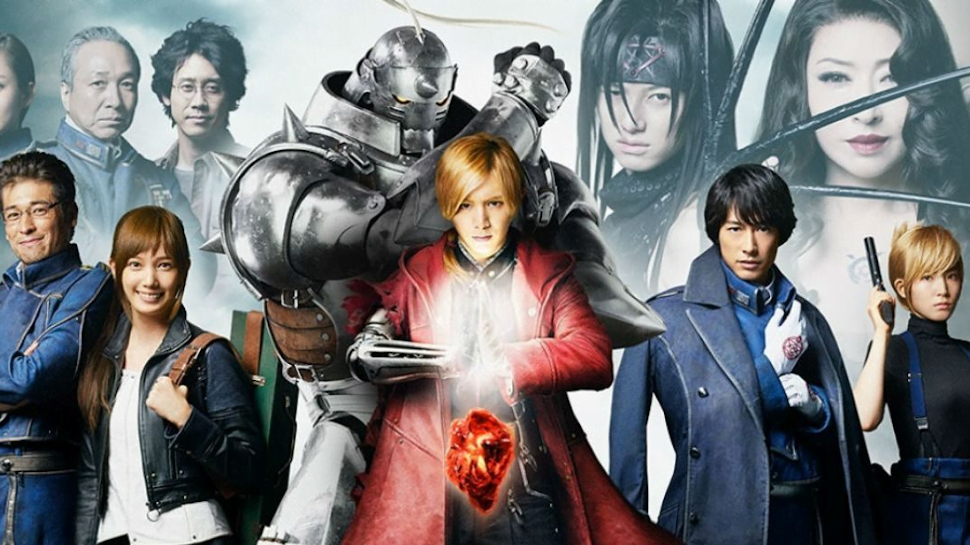
Games About America
I just checked, I’m still mad about it.
CoX: Shaping Moonheart
A few months ago I mentioned Moonheart, my Resurgence Magical Boy, and how I figured I’d go in on him when I had the chance.
Well?
I have the chance.
Okay, first up, we’re talking about a character I roleplay on the game City of Heroes. This is a fakey-madey-uppy superhero I pretend to be in my free time. If you’re looking at this and missed this introduction, you might be going ‘hang on, what story is this from?’ and ha ha, you fool, I’ve got you to read about a thing I made up.
Gotcha!
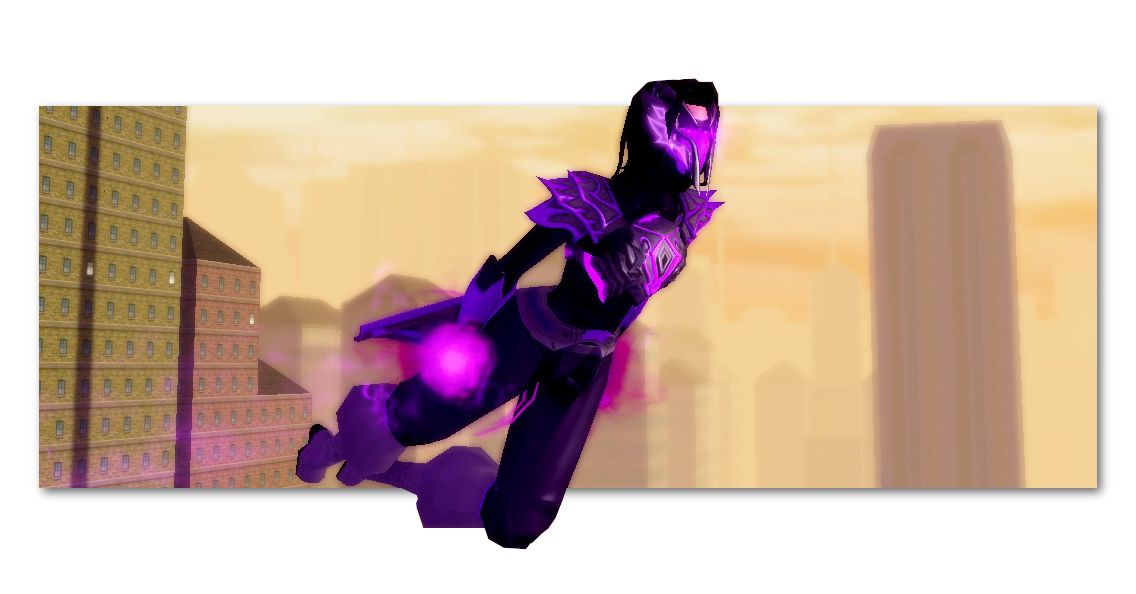
Moonheart is a young man from that category of legacy heroes; not directly, as neither parent was Moonheart before him, but as someone who inherited powers from each parent. If you meet him on the street, chances are you might read him as a woman, because of his hips and hair and his not exactly packing the masculine codifiers voice. He’s what might get referred to as a femboy – he’s cis, but his presentation is pretty girly.
(And that’s it, mind you.)
Game Pile: Fat Bear Week
Fat Bear Week is a three-level long game about playing a big, lumbery, hard-to-control bear that wants to get enough food to winter, in a time limit. You maneuver around with WASD and the mouse and try to contend with momentum and want to hit as many targets as you can, which can be static or mobile. You’re eating a bunch of things, which may be mushrooms or berries or whatever, or they may be birds or bunnies that try to get away, and at some point in your exploration, after you get enough food, your bear transforms into a Big Chonky Boy, and now you’re not chasing things, you’re rolling around and trying to manage what is essentially, a big spherical ball that wants to eat things.
It’s pretty fun and its control mechanism is just bad enough that wrestling your bear around is satisfyingly fun, in the same way that you’re kind of bowling your bear around. There are some unlockable bears, there are stars for doing a good job, and there’s a ‘complete’ stat with getting stars.
I like this game just fine, and it’s free, and it will take you less time to download it and play all of it than it took me to write this article and put the pictures together.
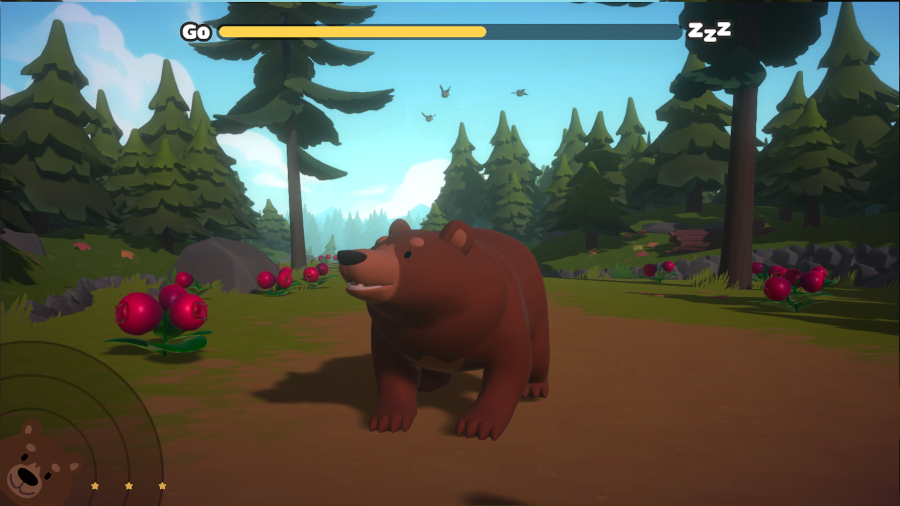
I found this game because I was browsing the games I bought in the Racial Equality Bundle on itch.io a few weeks ago. I did so by jumping to the end of the list of games, then worked backwards, page by page. I showed this one to Fox, and she played it, then I played it, we had a giggle, and that was pretty much it.
The bundle in question is so big that this game could have escaped my notice, and that’s a little sad and a little weird when I think about it. I even wonder if it’s worth doing a Game Pile about the game itself – it’s basically a tweet fodder.
There was also some idea, kind of kicking around in my head, that it was worth doing a Game Pile and going in on body normativity for this game, where it’s okay to be a fat player character, a big chonker, in a comedy game, but the conversation about fatness in a game seems best to be brought to bear on something that does a terrible job of it, something with multiple characters, and something that’s being made by people with large quantities of power and a clear means and obligation to do better like Capcom or Ubisoft, rather than an itch.io free game.
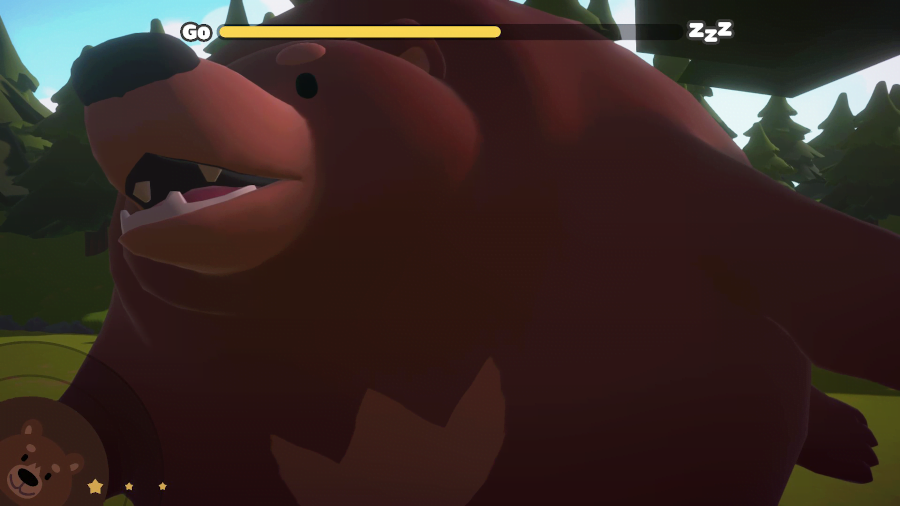
The thing is, this game is just… good fun? I like it? I wish there was more of it? And as much as I have a platform, as much as I can offer attention to it, I feel like it’s worth drawing attention to this kind of small project, something that could, hypothetically, be better, if the people making it knew that people wanted more of it. It’s part of an enormous bundle, and even outside of that bundle, it’s free.
I like to make a point that games of all varieties are worth talking about, worth consideration. My definition of games in an academic space is explicitly extremely inclusive, but I tend to not talk about games from this middle space. I’ll talk about a game my dog plays, but this game, which was made by people and I played and I found lots of fun, and may even yield more content if enough people are interested in it, somehow lives in a space where it’s too small to go off on but too big to be treated as one of those small games I promote and pick apart. A game I spent half an hour on is doing me a service, and my desire for more of it isn’t really a reason that the game should be discarded.
Anyway, check this one out, it’s free and it’s fun. And tell the people who made it what you think of it!
How To Be: Chandra Nalaar (In 4e D&D)
In How To Be we’re going to look at a variety of characters from Not D&D and conceptualise how you might go about making a version of that character in the form of D&D that matters on this blog, D&D 4th Edition. Our guidelines are as follows:
- This is going to be a brief rundown of ways to make a character that ‘feels’ like the source character
- This isn’t meant to be comprehensive or authoritative but as a creative exercise
- While not every character can work immediately out of the box, the aim is to make sure they have a character ‘feel’ as soon as possible
- The character has to have the ‘feeling’ of the character by at least midway through Heroic
When building characters in 4th Edition it’s worth remembering that there are a lot of different ways to do the same basic thing. This isn’t going to be comprehensive, or even particularly fleshed out, and instead give you some places to start when you want to make something.
Another thing to remember is that 4e characters tend to be more about collected interactions of groups of things – it’s not that you get a build with specific rules about what you have to take, and when, and why, like you’re lockpicking your way through a design in the hopes of getting an overlap eventually. Character building is about packages, not programs, and we’ll talk about some packages and reference them going forwards.
This month, we’re going to talk about the hottest of Pansexual Messes, Chandra Nalaar and you may be asking me ‘well why didn’t you do that during Pride Month?’ and the answer is because Wizards have not been exactly well behaved on this issue and I’m not about to do their marketing work for them just this moment thank you bloody much. Instead we’re going to talk about Chandra on her own time, thank you very much.
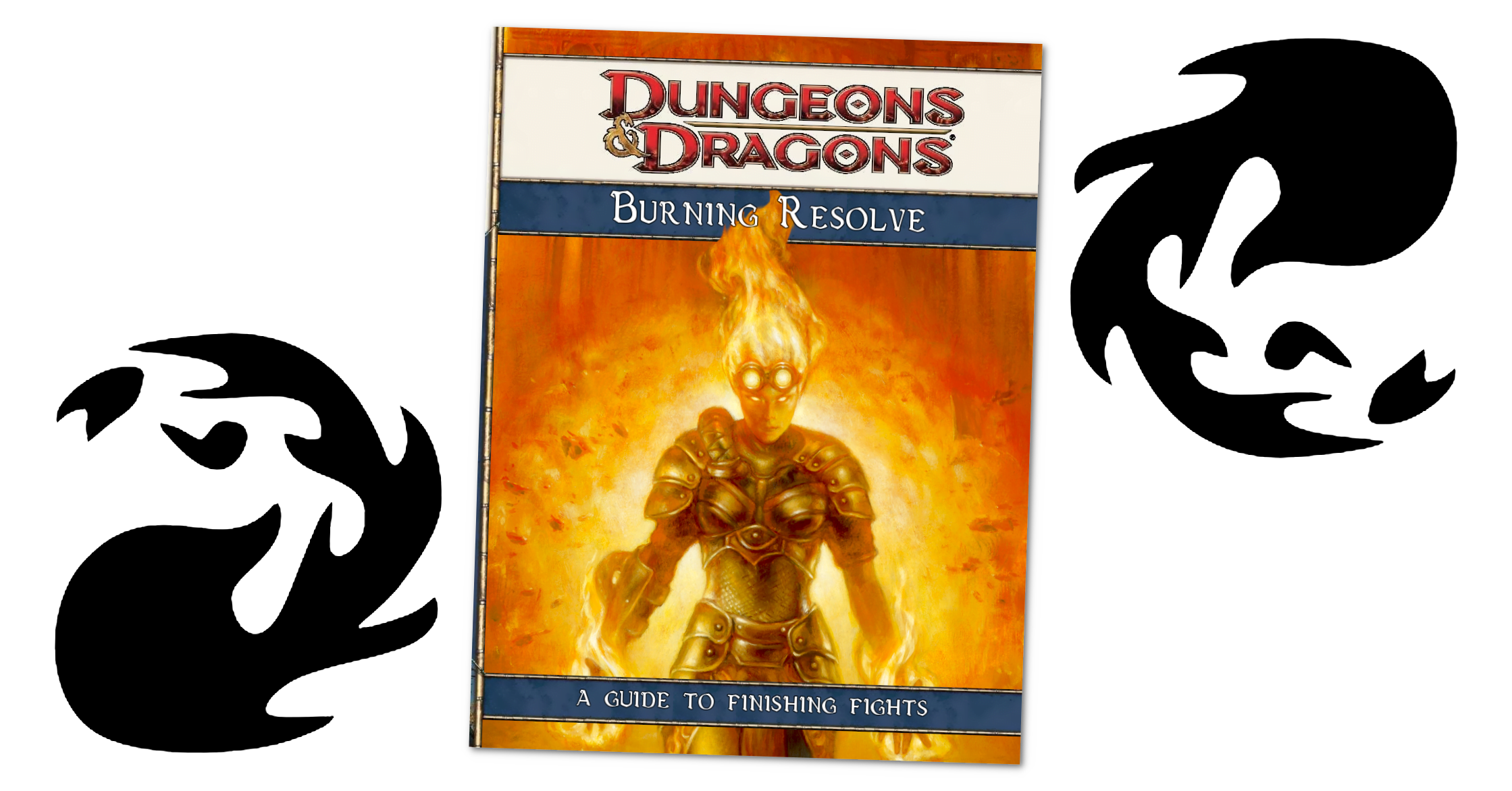
You Can Just Want Things
There are two categories of people I try not to make blog posts about. One is my students, the other is my family. They never signed up to be made into Hashtag Internet Hashtag Content, I don’t want to make the storytelling practice that seems to have been inherited from my father (that he called ‘preaching’) into something that exploits the people around me who are themselves living, breathing people who do do not want to be, nor deserve to be, pinned to this page as a moment that will live on in my mind and in the minds of others. Hannah Gadsby talks about this, how her own mother’s homophobic comments are effectively preserved in amber, as part of her show, meaning that even though her mother may have grown past those comments, Gadsby repeated them to herself and others endlessly for years.
(Gosh, I like Gadsby’s work)
Anyway, because of this I have had something repeatedly run into me in the past few weeks that I have resisted writing about, because again: I don’t want to write about these people in my life who didn’t sign up for it, even though they are overwhelmingly common and repeated experiences, which is usually a sure sign for me that it’s time to put some words down.
The good news is that after contemplating the difficulty of writing about this, I had the realisation that this isn’t something that’s bugging me when students and family do it, I’m just being bothered by everyone doing it, and that got me thinking about modes of communication.
Now, I am a fan of the work of Marshall Rosenberg, not because he was right about everything or because I’m an advocate for the fulltime adoption of nonviolent communication, but because he was very good at correctly recognising that our conventional communication model is about victory and it will get that through oppression or manipulation if we can. And as a direct result, I will ask someone the question, in my day to day, what do you want, and the people over whom I have some degree of power – be it infrastructural or social or familial – will seek to find ways to give me the right answer.
Here’s a base example, which in this case I use because the person it would otherwise be with is Fox, and Fox does not have this problem at all, so, if you’re reading this and trying to extrapolate, or if you are Fox and you’re going ‘hang on, I would never,’ I am using this as an example because you’re basically bulletproof. Nyeh. Anyway:
“What do you want?”
“Well, I was thinking that if we did the laundry on Tuesdays, it would get the drying done over the week rather than weekend mornings.”
This frames the answer not in terms of the want of the person saying it, but instead about a shared, perceived value of the result. It’s not that it’s bad to have this kind of plan, it’s that it’s not addressing the question. It might even be that this answer has the answer in it: I want the laundry drying during the week. That’d be enough! It’s the way that when the question is asked, the want is ignored in favour of the result.
It seems like such a small rhetorical thing, but it’s important. It’s important because if I ask you what you want and you respond with what you think I want to hear, I’m not hearing what you want, I’m hearing what you think of me. It’s a fundamentally passive position, and it means I don’t get to know you.
How’s this come up in fandom stuff?
It comes up in fandom stuff when people are unwilling to centre themselves, and their wants, and their responses to things, in the discourse about media.
It can’t be I want this scene. It can’t be I like this pairing. It can’t be I dislike that story trope.
It has to be this scene is necessary. It has to be here is how this pairing is a moral ill. It has to be here’s how my identity legitimises my writing.
This creates extremely weird behaviours. There’s a bit of a canard about the Hamilton fandom being what I will now in a comically understated way refer to as a bit lively when it comes to this. Oh, there’s Miku Binders and Fake HIV and the cannibal mermaids and all that stuff, but I tend to look at it in terms of a kind of pressure cooker. Hamilton takes something that’s very bad (the formation of America by a bunch of extremely terrible people), connects it to something undeniably good (kickass musical theatre), and then leaves this audience in this complex space, unable to grapple with the most important element of their interpretation, themselves.
If you can recognise yourself, if you can recognise your own wants, it will help you realise that you don’t need to prove the value of your loves. You don’t need to approach playing games as if every game is meant to become a career. You don’t need to watch anime because it will make you more cultured.
You can just want things.
4e: The Dragonborn
You may remember a while ago I talked about how, typically, in fantasy stories, dragons are used to represent governments. This idea isn’t like, hard codified facts or anything, it’s just a way to look at dragons and it can make some sense of how they behave when they’re used in stories. The thing is, that’s a sort of high-up view of what dragons are used for, and the ways we treat dragons because it’s the way we learned to treat dragons; they are, essentially, governments that you can interact with on an individual, personal level, which means that they can be petty and cruel and vain in ways that only involve changing one mind to fix or they can be benevolent and kind in the ways that an individual making reasonable judgments can.
But what if dragons were not only expressed in these forms, what if the role of the dragon in a story being a person means it is something that people can observe, can admire, can disconnect from its duties and the scope of its powers, and consider as a person that can be swayed, can be hungry, can have material needs, can-
Look, I’m circling around the question of whether or not Dragons Doink.
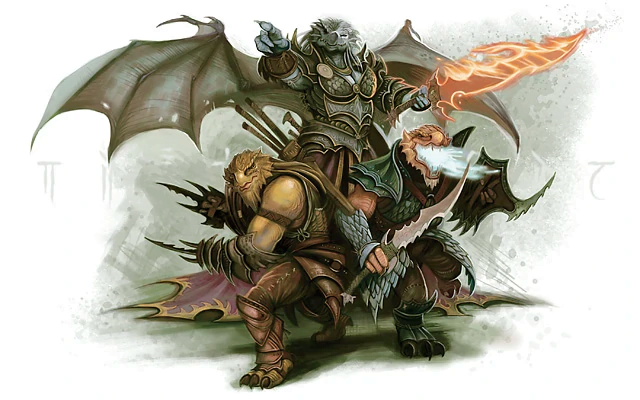
Story Pile: Fullmetal Alchemist Brotherhood
And then like the krispy kreme, we’re back at it again.
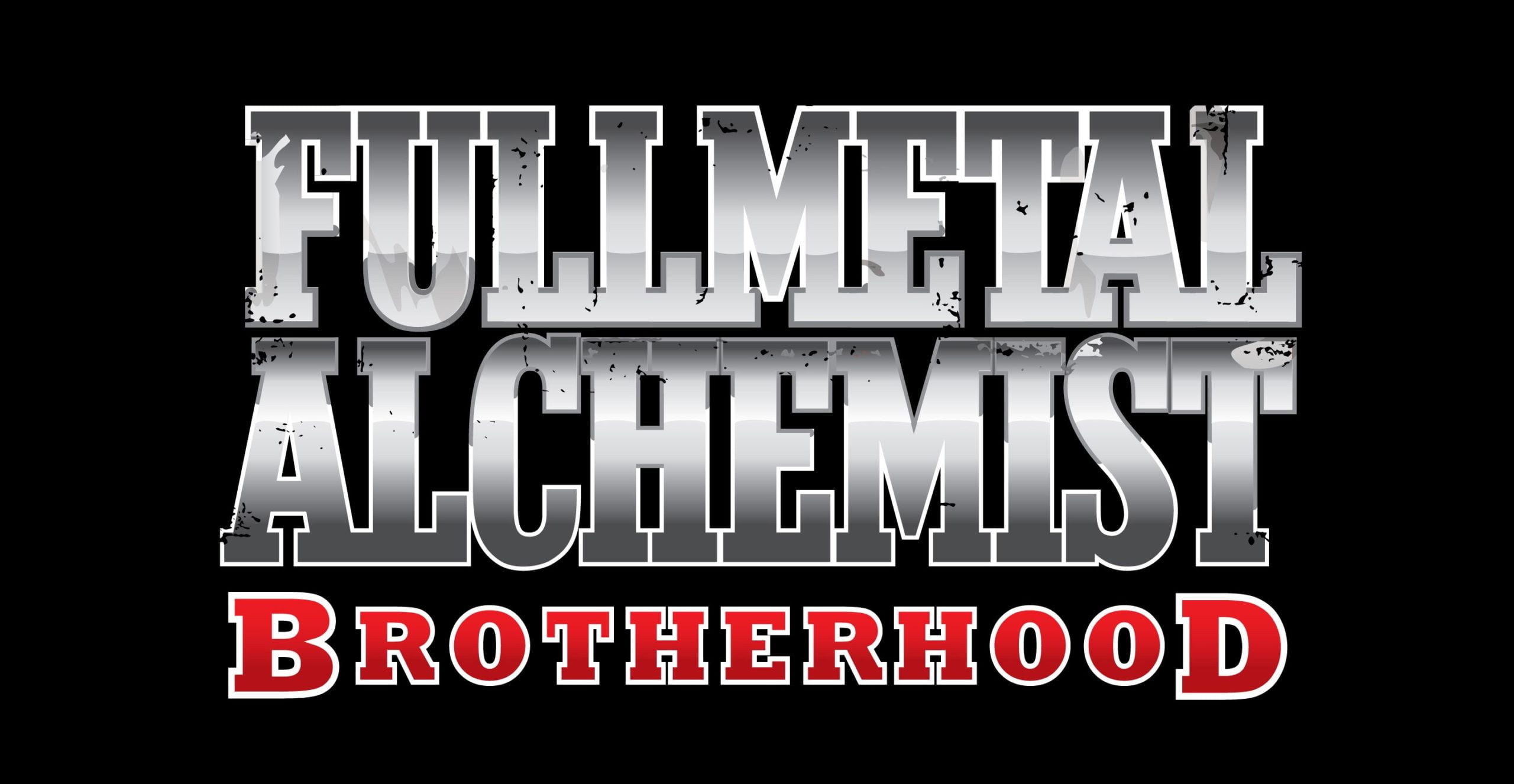
It’s very hard to deal with contrary impulses and present a fair position without being coloured by the arguments you had on the way to get somewhere, or by the arguments you’re anticipating. For example, while I may say straight up that Fullmetal Alchemist: Brotherhood is probably the best anime of its type that exists (mage-punk, long-running action-adventure character driven stories with themes of war and loss), there’s still the hanging asterisk that I was also pretty positive about Fullmetal Alchemist, and how much can someone trust my opinion on this one? And what’s more, how can I praise that anime and yet have qualified praise for this one, because that was a Bad Anime and this is a Good Anime?
Anime fandom is a mistake.
Anyway, the coda: I think that Brotherhood is one of the best anime of its type, and yet, I think that has flaws that merit critical attention; I think that it’s worse because of the 2003 anime, and I think that anime is treated worse for not being this.
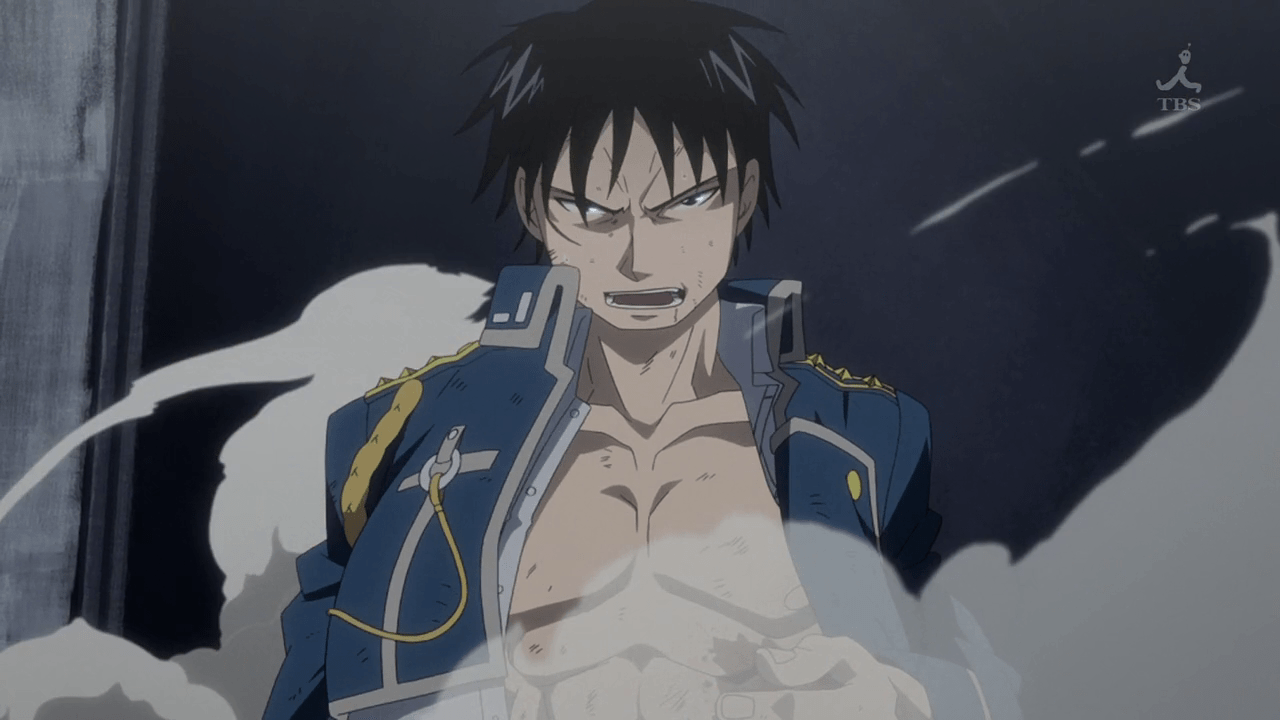
MTG: Reimagining The Nephilim
Warning: hey, WotC employees, this will feature custom designs!
In February 2006, Magic: The Gathering released the set Guildpact, and with it the first four-colour magic cards that had ever been printed. With no prior precedent to work from, these four cards were exciting and they had the intriuging and hitherto unused title Nephilim. They were the Yore-Tiller Nephilim, Glint-Eye Nephilim, Dune-Brood Nephilim, Ink-Treader Nephilim, and Witch-Maw Nephilim.
Nephilim are a reference to a sort of – you know, I’m going to pull the bandaid off and just say that Nephilim are one of those pre-Bible Bible stories that gets trotted out and recycled by various people building RPG Sourcebooks or Religious texts (but I repeat myself). There’s a chance your actual religion actually respects them as actual things that actually exist, but that’s sure not what they’re being used for these days.
Also, if you read the lore you’d know that these Nephilim aren’t the real Nephilim, they’re just magically crafted Nephilimmy things, and they’re sort of pre-god gods of Ravnica, creatures that are so transcendentally powerful and important, that they don’t even need worshippers or sacrifices – their cult calls upon them to be seen not because of their actions, but because of their existence being so fundamentally powerful and dangerous that their presence humbles people.
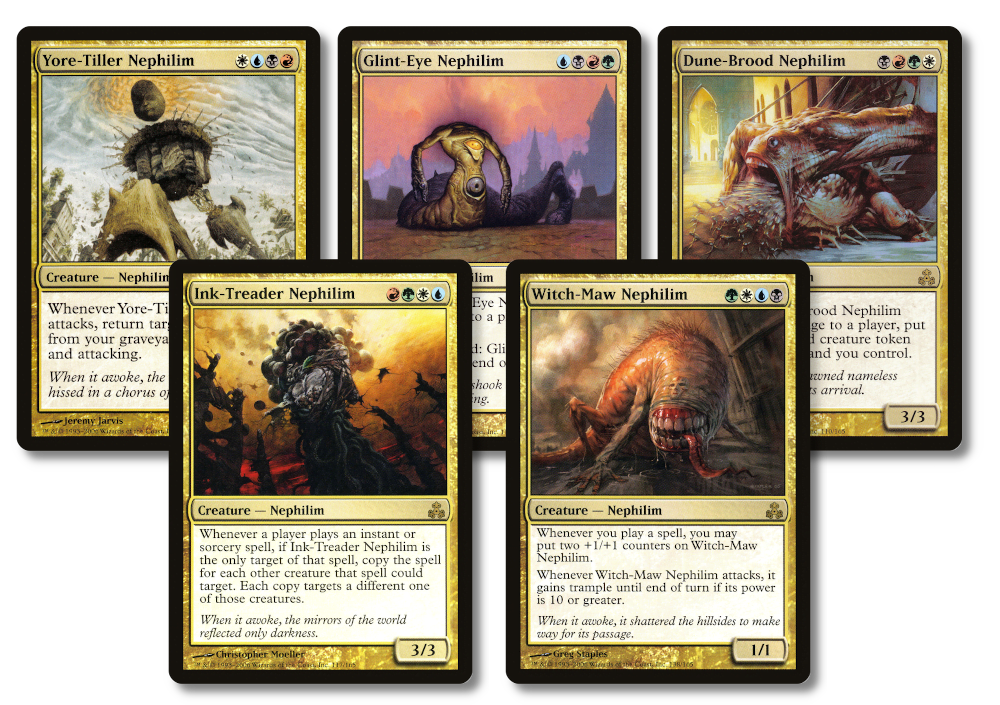
They also suck ass.
Continue Reading →The Seacons, or, Fish Got Feet!
I like the Transformers, but they are absolutely a universe where a lot of give and take had be done between what the toys could make happen and what the character designers could make work, and boy is that obvious when you talk about the Seacons.
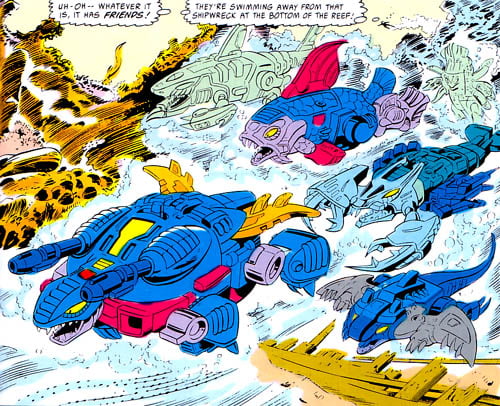
For those of you not already familiar, the Seacons are from that twilight-of-G1-not-quite-G2 era when dayglo purple and cyan were the thing, where gold plastic that turned to dust got produced in high volume, and where all the good, easy concepts and moulds from Takara’s stockpile had been used up. The transformers had run through their first wave of designs that could be cobbled together and it was time to start expanding into the less obvious, less easy model kit things to turn into transformers. The toy with a gimmick of transforming robot aliens already had the idea of transforming robot aliens that could slot together to form bigger robot aliens, and that meant new designs had to make new groups that could combine.
Continue Reading →Game Pile: Secret Agent
How much can you get out of how little?
Continue Reading →A Completely Honest Accounting Of A Day
I went to sleep at two.
up late trying to make sure I could get that text done, checking and double checking that everything I’d done had been done up to scratch, some last minute surveying of tomorrow’s notes about the PhD writing ugh got to make the road map got to make sure I’m productive
I woke up at nine.
head hurts but that’s normal how it goes really who doesn’t feel like ass right now but I’ll make sure I can sniff something or taste something because it’s very important, if I can taste things that means I’m probably not sick with covid
I couldn’t see things by ten.
this I understand, this is how I get at cons when I’ve been sleep deprived for a few days in a row, when I can’t sleep due to stress and anxiety, so I start noticing these black patches in my vision the nI have difficulty processing visual information like text, can usually hold it together but hang on why do I need to –
I went to bed.
whumph
I woke up at six.
still felt a bit bad
I had dinner, I talked with Fox, I watched Youtube with her.
we had mcdonalds and watched Overly Sarcastic Productions
I sat here in the dark, feeling warm and comfortable and happy.
I met obligations today, even though I wasn’t feeling well, and even if I hadn’t it’d still be okay, it’d be okay to not be productive; but I was able to be, and I should be proud of that, because it was above what I needed to do
And now I’m going to try get some sleep.
it’s okay to have bad days and I need to tell myself that until I can believe it
Purpling Out A Warshade
I swear to god, my last fucking brain cell.
In City of Heroes, the game was – and is – pretty easy. The game was made to have a broad appeal to an audience that mostly liked playing with the costume creator, and at shutdown, over 50% of all characters made never reached level 10 of 50.
There was a gear system introduced after the game was live, a system designed to be optional to let players push their characters to a higher level. It was called the Invention system and it relied on interconnected sets of things in limited sockets. I’ve spoken about it in the past and it is not an easy system to grapple with.
This was, I repeat, optional. Then when that system appealed to players, the developers released another group of inventions that could only be used by characters at the level cap, at 50. This is content for a minority of players, mind you, and they found it worked well getting players engaged with the game, and it seemed to do well. They were known as ultra-rares in the game text, and ‘purples’ to the players. For some players, doing normal late-game content, a single purple drop could be sold on the market for enough money to satisfy your needs for good.

Another thing in the game was the presence of epic archetypes. If you had a level 50 hero, you could make one of two more types of hero characters – a Peacebringer or a Warshade. Of the two, the Warshade was the weaker and less popular. There were a lot of reasons why they were less popular, and you should totally explain to me why you think that is I promise I won’t ignore it because I don’t care and it doesn’t matter, but okay, this is the framing you need.
One day on the forums, a typical thread got kicked off; someone talked about how the game market was broken and it was too hard to meet basic needs and it was too expensive to function, a position that largely, I and other market people didn’t regard as very serious, because the market was very easy to make money off if you were patient and so on. It was a libertarian paradise – all goods were luxury goods and everyone had equal access to the means of generating capital.
Then Chris Bruce, aka Back Alley Brawler, responded to this thread, and pulled the vital quote from the start of the thread that we’d all missed:
I’m sorry, did you say it was too expensive to purple out your warshade?
This quote haunts me.
This quote is the kind of rhetorical bodying that I’m honestly afraid of earning. It is a statement from a position of such flawed base assumptions that even a reasonable sounding conversation can be formed around it, but to anyone who bothers to pay attention, it is completely farcical on its face. The most entrenched of entrenched players bemoaning the difficulty doing one of the hardest things that casual players were never expected to want to do, showing their populist position was just selfishness in disguise.
I worry a lot about when I explain things or share things or call for change that I’m not complaining about purpling out my warshade.
Reaper Space
don’t go there
it’s reaper space.
Everyone warns you when you move through the ports and bases and outposts. It’s the big zone where ships don’t travel; trade routes route around it; no corporate rig will travel into Reaper space at all. Not any of the big ones, at least, not one of the superheavies. Reaper space is uninsured space. Nobody’s dragging you back out of that.
You haven’t seen a Reaper, of course. Nobdoy has, or if they have, they don’t know it. Nobody’s that sure about the way the Reapers look, though there are a few of their artifacts. You’ve seen one – hanging once in the foyer of a citadel, dangled from the roof, this immense machine that looked like a tank, with an entire assortment of blades on the front and an enormous engine out the back, seemingly made to do nothing but plow forwards; the blades were attached to a wheel, which was itself screwthreaded – so each blade flicked and clacked and dug into the air when they ran the machine –
Which they did, for a little bit.
For demonstration purposes.
Watching it turn an entire shuttlecraft into pieces with all that sound, the shredding and breaking.
Brr.
It’s not like you need to worry about Reaper space. Reaper space has barely any planets in it, and there’s only one outpost out near the dead zone that serves as a border to Reaper space. Maybe a few planets, sure, probably with some cultures on them that are probably not spacefaring, or if they spacefare it’s to do minor, small trades – the trades of a culture that doesn’t have an empire or corp yet – and when the talk of reapers happens they just shut down their satellites and pretend nobody’s home.
There are pirates, of course.
After all, uninsured space is unpatrolled space.
Gotta be careful out there. It’s Reaper space, but it’s full of scum and villains too.
Story Pile: Fullmetal Alchemist – The Anime
In 2003, the then-ongoing Fullmetal Alchemist manga launched a new anime, which took the series’ adventure story and complicated scientific-based material magical power system reinforced through firm, rigidly defined character interaction, and made it into an affair of visual spectacle. This was a good decision because all the pieces were in place to make a great action adventure anime, with a dash of horror, with the promise of riding the popularity of the manga readers that were following eagerly along with the manga.

.
Now, conventionally, and certainly back in them nineteen hundred nineties, when an anime is made out of an ongoing manga there’s a bit of a logistical problem that seemingly everyone knows is there and it’s coming but most people involved don’t seem to think it matters. You may also know this as the Game of Thrones problem where a show is being made to follow another serialisation that is moving slower than the original. With the right kind of head start, sometimes the manga and anime can come together and land the same ending at the same time, but it rarely works out that way.
Continue Reading →Omission Culture
Cancel culture’s not a thing?
The Cultural Cringe and Brolonialism
There is a term used in Australia, which is known enough to have a wikipedia page but not known quite so much that I can assert it in a classroom and have people react with ‘ah, yes, that,’ which describes our relationship to the art, media, and creations of our own culture. The term is cultural cringe. Coined in the 1950s by A A Phillips, Cultural Cringe was seen as an Australian problem based on our relationship to ‘real’ culture in England and now, more recently, America.
Game Pile: Planet Lunch
Sorry, this isn’t going to be about a game you can play. But maybe you can. I wouldn’t advise it.
In Homo Ludens, the work that is often seen as base camp for clambering up the entire horrible mountain of games scholarship, a peak that is dotted about with just a stunning amount of racist, sexist, and ableist bullshit, Johan Huizinga begins, in the introduction by talking about how game playing is not a human activity, it is a cultural activity. Generous readings of Huizinga even go so far as to extrapolate from his position that games are important to culture because culture is made up of play.
It is not so much that cultures need games, but that without games, cultures wouldn’t exist; the capacity to give and take, to test and tease, is part of how cultural entities react to one another, and that, Huizinga-interpreters suggest, is one of the building blocks that means you transcend from existing as groups and packs, and begin the communication interchange that forms a culture.
I’m by the way coddling this because I read Huizinga a few years ago, and I read a translation so I’m always nervous of telling people what was in the text if I can’t provide chapter and verse quote. There’s a lot of stuff in Huizinga that isn’t really as prominent as you’d think it would be considering you have the phrase The Magic Circle bandied around everywhere but which Huizinga kinda only mentions once, and not in much depth.
Anyway, the thing is, any human reading the book is a byproduct of a culture and that culture has play already in it. If you want to talk about universal traits of cultural projects one of the easiest ways to prove you’re not just supposing things out of the air is to look around and find places where we can find the rule holding that aren’t necessarily obvious and which reinforce your point Where Clown-Hater and Skulldick Cultist Roger Caillois favoured pointing to ants getting high as his proof that there’s a fundamental desire for what he called ilinx, an idea that exposes a lot about how what he thought about how ant brains work, Huizinga’s introduction examines something a little more relatable as far as humanlike minds go:
He draws the comparison to the fact that wolves, without human interface, will play and invent games.
This is a point that I can remember because it shows up in the introduction and I was deathly afraid of mentioning it in my essays for fear that I would be asked about something much later in the book that I hadn’t gotten to yet. It’s also not a thought I think about too much, because I don’t tend to think about Huizinga much at all.
Then we got the Kong Gyro Ball.
We have a dog. His name is Elli. He is a good dog, and his name is a great litmus test for who can pay attention to being corrected on pronouns. Elli is a whippet, and Elli has anxiety. Elli doesn’t like other dogs much – he’s intimidated by them, and his reaction to them is to try and run at them very fast and bowl them over, or while making a lot of noise. This is non-ideal behaviour. Elli is also extremely energetic when he’s active – he wants to run really fast for about… a minute then come home and flop down for a few hours.
Lockdown has not been kind to Elli. First, due to the cold air and existing respiratory problems, Fox has been unable to walk him very regularly. That means I’ve been doing it mostly, and when the weather is rough, it’s not doable. Plus, because of his anxiety, we want to walk him when nobody else is – which has made for midnight walks, in the extremely cold weather, which isn’t great.
Fox has done something for him, though; of late, we’ve been feeding him out of the Kong Gyro.
This isn’t sponsored, by the way! This really is just a product we use in our house, and just because Fox or I play a game doesn’t mean we’re the only people who can or do play games.
It’s a pretty simple little toy; you put his food in the ball, and then he chases it around the house trying to get the food out of it. Thanks to a sense of smell and a sense of disappointment, when the ball stops paying out food, he’s pretty able to extrapolate that it’s empty (thought not always). It extends meal time, it adds interest and it gives him something to do in just about the right unit of time. Elli is not a dog given to enormous expenditures of stamina after all.
I didn’t think that much of it – it’s a thing we did, because it gave him exercise. We were making his dinner and breakfast difficult, and we were doing that because it needed doing in the circumstances of the world right now.
One night, we couldn’t find it.
We went to feed Elli, in his normal bowl, and – like, it’s hard to say for sure how to explain this to people, but he seemed profoundly disappointed when Fox went for his normal bowl. Oh, excited – because biscuits are biscuits and chicken is chicken – but still, he looked around for the Kong. And then, in response to that, I resolved to go looking, to try and find it, even moreso because because damnit, he wanted his lunch planet.
When I found it, it was in his bedding curled up, and under a blanket.
He had emptied it, eaten out of it, then carried it with him, empty, to be near him while he slept.
Now, the next big lift here is the question: are dogs non-human?
Giant Green Angry Baby
In The Transformers, the very serious advertising campaign about alien robots that transform into cars, planes, dinosaurs, two boomboxes (ask your parents), a vending machine and an enormous twelve-meter tall microscope, there are collections of toy robots that can be stuck together into single bigger toy robots. We’ve talked about them in the past, when I talked about the Protectobots and the Stunticons, where you could collect a set that was a squad which had its own internal dynamic, leaders and friends and followers. It was a really neat marketing gimmick, where you could Consume Products in a way with both a targeted list, and a reward for achieving all parts of that list.
These squads also tended to be written to have a bit of personality, based on the cards that they had on the back of the boxes, or the guidebooks you could buy and the maybe-sometimes-eventually-expressed-in-a-comic way that the show did to express character. The fact is in the TV Show, most Transformers were as much an accent and a hand to hold one of a number of blue-or-red lasers, with very few of them having a chance to really put forwards their characterisation compared to just filling space in battle scenes. Oh, there were single episodes that focused on single transformers from time to time, but they rarely got to build a large amount of context. I don’t remember any episode where Trailbreaker’s fear of being overconsumptive of Energon paralysed him, nor any instance of Windcharger magnetically tearing things apart.
But that doesn’t matter because Transformers is a canon made up of a shotgun blast of ideas, and what sticks tends to be what any given writer could put together. When dealing with our girls the Stunticons, it was picking any given list of personal neuroses and jamming them onto the toys they had to work with.
And that same policy got to be used on the beta model gestalt, the first step mistake that was Devastator.
Minecraft: Hopper Minecart Loader
3.0 D&D : The Spelldancer
In my mind, I see D&D editions as a map of the same general world, scarred about with the history it lives; because no edition is really gone, and the game rules still exist and are still played (yes, even right now), it isn’t correct to see them in terms of a linear flow of time as much as regions of related space. Some are earlier, were founded before, but they are all here.
When I think of them this way, though, they take on their own character. Basic D&D seems more bucolic, smaller and older, and a space made up of its own adventures. Characters are all reasonably similar to one another, and perhaps the entirety of what Basic D&D is can fit in one valley somewhere. The First Edition is a place of broken empires, and old world lore, a place where the reality itself doesn’t quite make sense, and people must exist and coexist with the strange storybookness of how buildings stand and fall. Second edition is vast, an enormous sprawling empire of nation states scattered about, with whole nations and planes built out underneath it, subjugated and commanded even as they utter their strange national shibboleth of don’t ask about thaco.
I do not know these places, I do not know these people. I have but passed through their lands.
Then there come the spaces I know.
Fourth Edition is a nation of stout borders; bigger than it should be, perhaps, but still reasonable. It did not overstretch its means, there are no strange, raggedy places where it tried to build where it could not. What lives there makes some sense; even the most powerful and terrible of its people are still recognisable as people. They do not stand apart from one another as strange and alien. There are the Essentials places, where the rules are smaller and simpler, the buildings boxier, but broadly, it is a kingdom where the roads all run the right way and there’s no eldritch horrors lurking under the bed.
But 3.5 is right next door, and it spills out and around like a sinuous, corrupted beast. The lines of where it ends and begins are fuzzy. There’s a little extradimensional space there, between it and 3.0, where there’s a book called Ultramodern Firearms that would be disturbing if it wasn’t just really bad. There are monsters in these spaces, creatures that wreck the world just by their breathing, things where the alchemy of character construction come together and the water runs black after them. If you know them, you know them, nonsense like Punpun and the pile of Warforged cultists. Things that could hypothetically be done. Power that needed arcane rituals to make happen.
But there’s worse.
What I need you to understand is what I’m going to tell you about now is a 3.0 character option that’s probably about as broken as you can get and you can get it accidentally.
Oh yes.
We’re going to talk about the Spelldancer.
Continue Reading →Story Pile: Fullmetal Alchemist – The Manga
There are a certain number of pieces of media that I don’t tend to want to talk about.
Sometimes, I don’t want to talk about a piece of media because I’ve never seen it, and in order to comment on it, I’d have to seek it out, and I don’t imagine I’ll be bringing anything new or interesting to the table. I’m a white cis guy, and lots of white cis guys who are straighter than me have worked very, very hard to make sure that if you get a ‘standard take’ on anything, you’re getting it from some variety of white cis guy. Watching The Room so I can say ‘yes, this sure is just as bad as I expected’ is not, to me, a valuable use of your time or mine. If I’m going to hatewatch something it’s because I know there’s something in there, some perspective I can bring to bear that’s interesting.
There’s also stuff I don’t talk about because I’ve been specifically asked not to talk about it. That is, stuff that I am known as being negative or critical about, and where sensitive people have asked, fairly nicely, for me to leave them alone as topics.
There are still works I don’t talk about, though, because they’re so good and them being good is so well known, I’m not going to tell you anything new by doing it. I don’t think, really, there’s a single thing I can tell you about Avatar: The Last Airbender that isn’t already done better by someone else, I don’t think that I’m going to provide a single extra angle on Inception, and even if I did have something to say (‘it’s fine,’ at best), I don’t find my opinion interesting.
The idea that my opinions are inherently interesting is the plague of privilege that I absolutely do not want to be comfortable.
Why then, would I talk about Fullmetal Alchemist?

Hey, Kid, Wanna Do A Podcast?
Do you wanna make a pod-caaaast?
Do you wanna notice ums
The ways you hold your breath
And silence like death
And making reference to bums?
•
We’ve had a lot of time on mics lately, haven’t we? Maybe you’ve learned a little bit about crosstalk, maybe you’ve even lashed out and got yourself a nice new mic, for work purposes? And you might have been binging content because everyone is doing that right now?
Well, you should try and make a podcast!
About what? Well, that’s going to be up to you. What this post is about is giving you tools and techniques and resources.
First up, tools!
Zencastr is a recording program that runs in your browser window and runs a call that it then records. This is really useful if you’re doing a podcast with your girlfriend who lives a thousand miles away in Canada (and that’s not a joke), because you can just hand her the URL to the page, press the record button and Zencaster will record all the audio for both of you. It’ll be synced up, you can bring in up to three people on one call in the free version. It’s a solid resource! What’s more, it can put all those files automatically into your…
Dropbox! This is a good way to keep large, shared audio in a controlled space when you’re collaborating over distance. You may not need this if you’re just recording yourself (though we’ll talk to this). OneDrive can do something similar, but I don’t have direct experience with that, so I wouldn’t say.
Audacity! This is the bread and butter of audio recording. This is a very rudimentary audio editing program, and if what you want to do is cut audio up, delete some passages, clean up background noise and maybe filter out mouse clicking, this is going to do the task just fine. You will need an encoder to record mp3s, which you can learn about here, on this Lifewire page.
If you want to distribute your podcast, I’d recommend you set up a WordPress blog and use the Podlove add-on. These will step-by-step you through the process that lets you make an RSS feed that people can search up using their existing podcast recording software.
That’s it! That’s all you need, really!
I recommend for your first podcast, you either talk to a friend for about half an hour, or you recite or explain something you care about for about five minutes. The former you have room to react to one another and come to understand how hard it can be to use the time you have, and the latter shows you how much effort goes in to making those five minutes meaningful and clear. If you have plans for fiction and storytelling, try reading someone else’s story for a little bit – not releasing the episodes, just reading them – to get an idea for how quickly you can go through a story.
Finally, Freesound and Kevin Macleod’s Incomptech are excellent resources for sound effects and music.
Hope this is helpful!
The Points of Light
Recent conversations about racism in D&D-
Oh yeah, uh
This isn’t going to be about that. That’s a pretty heavy thing. This is a light one.
Game Pile: Hero Realms (And Ruins of Thandar I Guess)
Sigh.
Why not, White Wizard have a kickstarter going right now.
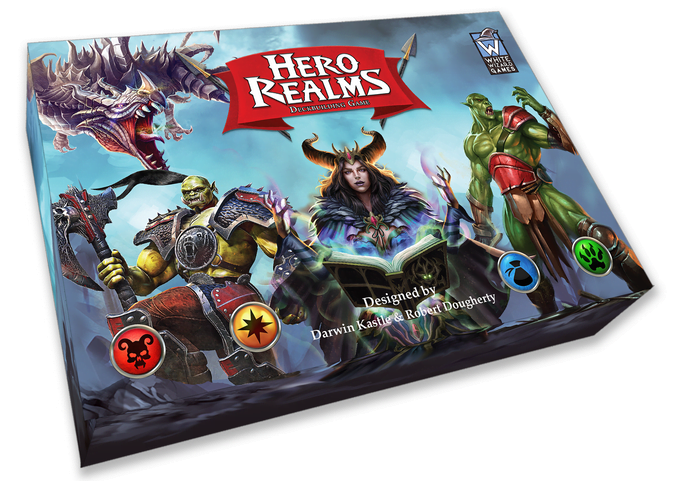
A List of Things I Don’t Really Know Much About
Time to time I’ll have someone ask me questions or suggest topics and while I’ll give everything a go, sometimes I have to use complex topics I don’t understand to launch off into spaces I do. That’s why Fullmetal Alchemist is a great place for me to talk about Paratext, but not so much a place for me to talk about guns.
Here then is a short, non-comprehensive list of things I don’t know much about
- Cars. Pretty much all cars. I know the basics of how a car works, in that there’s an air-and-fuel engine that makes tiny explosions that drive some pistons and then the rest is just controlling that and making it work well, but that’s all I got.
- On that front, competitive car racing. Grew up surrounded by it, met some very important people in it, no clue how it really works. I have a tiny bit of knowledge about one thing in NASCAR and that’s it.
- Firearms. I’ve never handled one. I think I may have handled pieces of one at some point but I genuinely think I’ve never been closer than five feet away from a gun, and that was probably on a police constable’s hip. Any conversations I have about guns are going to focus on culture around them rather than the devices themselves.
- Modern military operations or aesthetics. There’s a real space for people like me who know their asses from their elbows talking about ‘real soldiers’ and whatnot, but that ain’t me and if you see me commenting on it, odds are good it’s because I’ve read something someone who knows about it is saying.
- Makeup. I have applied it once or twice to other people and experimented with using it to hide injury. I do not know anything meaningful about it.
- Recent anime. I’ll check out some stuff that gets recommended, but only once it’s all done and nothing that needs a hundred damn episodes. I want enough familiarity to talk to people at cons, not enough to go all Mothers Basement on things.
- Driving. See also cars: I don’t drive, don’t know how to drive.
- Code. I have opinions about how people should talk about code but I don’t know how to do anything more complicated than Twine or Wiki coding.
- Ways to divert the flow of history by killing, meeting or changing single events. I just don’t know this stuff. I know there are some people with firm opinions on it, and I think it’s a good idea to consider the ways that individuals have diverted history through accident, but I am by no means an expert.
- Islam! I have some broad, general criticisms of religious institutions as institutions, but if you asked me to provide specific criticisms of Islam, I wouldn’t know where to begin, and it wouldn’t, I imagine, be interesting at all.
- Oh and while we’re at it, Judaism! Everything I know about Judaism is filtered through a fundamentalist Christian background. I may know more than you expect, but I don’t know anything about Judaism as she is lived today. I may know some things that are meant to evoke jewish-ish-ness, but you can fill a barn with what I don’t know here.
- Stand up Comedians! Lots of these guys blur together, for me! And I do mean guys!
- Music. I can tell you how music and lyrics make me feel, but I am clueless about how to make music. I don’t know how to sing well, I just know how Choir drilled me.
- Game Theory. This is a wing of mathematics, and I don’t know much about it. I do Game Studies, which looks at games as cultural entities. There is some interesting stuff with ‘Game Theory’ but it’s mostly about the idea of rational actors responding to incentives, like much of economics, rather than anything to do about how political agents move.
- Carpentry. Not a clue. There’s this thing that Ian Bogost has talked about, with using the term to refer to doing philosophy through making stuff, but actual joinery and stuff? Not a clue.
- Yu-Gi-Oh. It looks like a game that has nothing meaningful in common with the games I play, but looks like it does if you don’t know either game that well.
Why this?
Because I think it’s worth taking stock and thinking about what you’ve been asked. I want to be able to hold on to the ability to say I don’t know and not have that be a wound against me. It’s nice to feel like an expert, it really is – and I try to limit that to when I’m dealing with students, who I actually have an authority over and where my expertise is what they’re literally paying for.
Everywhere else, it’s important to hold on to your own capacity to be a dumbass.
Why Your Cards Against Humanity Variant Sucks Ass
Because the base game you’re templating off sucks ass.
That’s it, we’re done, easy.
Content Warning: I talk a bit about, you know, The Cards Against Humanity creators and obliquely talk about recent events that weren’t recent when this article got started.